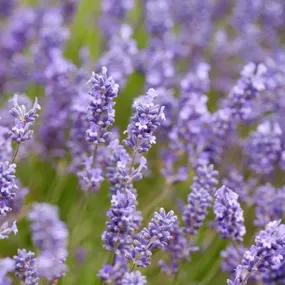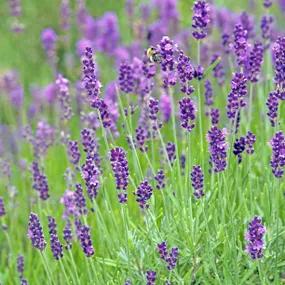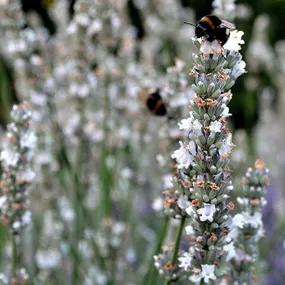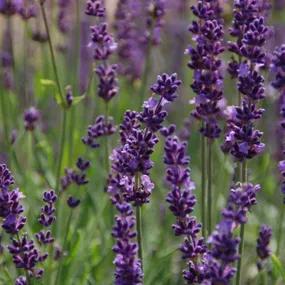Order Dutch Lavender / Lavandin Now For Delivery From August
- Order now, pay later: we don't charge your card until before delivery
- When your order is ready: your mail order hedge plants are delivered by next working day courier (not the next working day after ordering!)
- Friendly support: if there is anything wrong with your plants when you inspect them, Contact Us within 5 working days
- UK Grown: using peat free compost
Delivery Prices
A typical delivery charge for potted shrubs like Lavender is £8 to £15, depending on the order size, if there are no larger plants like trees in the order as well.
Delivery is calculated automatically during checkout after you enter your delivery address.
Delivery Season
Lavender should be planted into warm soil.
If you plant it too early, before nighttime temperatures rise, the roots get shocked and set back, which is especially bad for little plants.
- The smallest lavenders, in P9 pots, are never shipped before May
- The larger pot sizes are usually shipped from the end of April, but cold weather like we had this year can delay
Delivery Lead Time
- Typically 2 weeks if the plant is in stock, rather than available to order before its delivery season
- We process orders in batches to keep costs low
- We keep you notified by email
Choosing a pot size
- For window boxes and other containers, starting with the smallest, cheapest plants in P9 pots is great because it pots these little plants up while putting them to use ornamentally
If you plant P9s out directly, the best time is late-May into June when the soil is warm and there is plenty of growing time before Winter - For quick borders, hedges and edges, or single shrubs that provide instant impact, larger plants in 2 litre pots are ideal. You get more root and more flower in the first year, and they do not look lost planted as a hedge at one every 13" (33cm)
- For filling a spot in a mature flower border with a lavender muffin-mound, or for a truly instant lavender hedge, 5 Litre pots are the largest we grow. We reckon Lavender sold in pot sizes larger than 5L has a higher failure rate in its first Winter.
How many plants per metre?
Spacing a Lavender hedge: Like most evergreen hedging, the default spacing is 3 per metre, 33cm apart in a single row.
Choose A Lavandin Variety for Me
Grosso is the best in the world for oil production. However, for smelling strongly in the garden, Edelweiss is even better.
Vera is the largest Dutch lavender variety we grow.
Growing Lavender
Read our full guide on how to grow lavender, with a quick Autumn pruning video.
Lavender FAQs
- What's the difference between English, Dutch, and French "Butterfly" Lavenders?
- Can I grow Lavender in the Shade?
- Which Lavender variety is best for cooking?
- Harvesting Lavender Flowers for Oil or For Drying
- Potted Lavender 8:8:8 Watering Rule - More of a Guideline, really
Best Hardy Lavender Varieties for the North of England, and Scotland?
All Dutch lavenders are RHS Hardiness Rated H5 (-15C to -10C), fine for cold regions
Planting Lavender
- Lavender prefers a sunny, dry, windy site, and cannot tolerate damp soil in Winter.
- Plant outdoors in warm, well worked soil from late April at the earliest, through to early August.
- Plant in pots at any time, using a sandy, well-draining potting mix.
To keep the base of the plants above heavy clay ground, try creating mounds or ridges to help drainage and air flow, using added organic matter and large particle sand (not smooth sand) or pea grit mixed into the clay.
Lavender Care
- Pruning each autumn is essential to keep them bushy and floriferous. Avoid hard pruning into old woody growth beyond a visible leaf bud, even a tiny one is fine.
- Regular dead-heading throughout the season will promote repeat flowering.
- Trimming in spring is not essential, but keeps plants tight and bushy and flowering at their peak.
Lavender's aesthetic appeal naturally declines after about a decade in most locations, even with diligent care, so it pays to take cuttings from older plants as their replacements!
Which Lavender Species is Best?
There are 3 main Lavender species widely grown in the UK
Lavandula x intermedia is Dutch Lavender or Lavandin. This hardy hybrid species is vigorous, and makes the best pot-pourri, candles, and insect repellents due to its stronger, more stimulating camphor-rich fragrance.
- L. angustifolia / officinalis is English Lavender, which is hardy and the best species for cooking and aromatherapy with its sweeter, overall more soothing scent.
- L. stoechas and L. pedunculata are both French or Spanish Lavender, and have distinctive "butterfly ears" on top of their flowerheads. Less hardy. Best looking flowers. Should be grown in pots and taken indoors in colder regions during winter in the North & Scotland.
All varieties can be clipped into low ornamental hedges, ideal for edging the base of borders and planting around the feet of taller shrubs like roses.
Being of Mediterranean coastal origin, they thrive in a poor, free draining soil with full sun and good air flow.
The most popular intermedia Lavender varieties are Phenomenal, with deep purple flowers, and Grosso, with paler, more "true Lavender" coloured petals.
Vera is the tallest cultivar, but it must be hard pruned yearly without fail, otherwise it gets sparse quickly - this is true for Lavender in general, but you can get away with missing a year with most other varieties.
What is the difference between Lavender and Lavandin Plants?
Most Lavender grown in UK gardens is Lavandula angustifolia, known as English Lavender. It is easy to tell it the difference between English Lavender and Lavandin when they are in flower:
- English Lavender flower heads are more sausage shaped, are closer to the plant on shorter stems, and tend to be deeper blue-purple colours (excluding pink or white varieties). All the little flowers are bunched together in one flower head at the end of the stem.
- Dutch Lavandin flower heads taper to a point at the end, have longer stems that hold the flowers well above the foliage, and tend to be lighter lilac-purple colours (excluding white varieties). There will be one main flower head at the end of the stem, with up to one or two small ones lower down.
English Lavender should start flowering around 2-3 weeks earlier than Dutch Lavandin.







